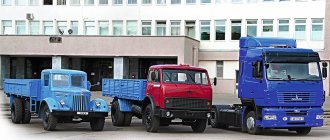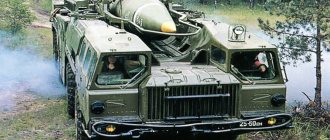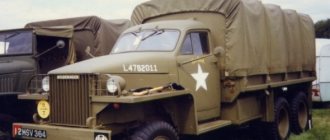The history of one of the largest enterprises in the Russian automotive industry, the Gorky Automobile Plant, located in Nizhny Novgorod, goes back more than 80 years. During this time, designers created more than 40 basic models of trucks and cars, as well as a huge number of their modifications for civil and military needs. Both today and in the middle of the last century, cars that rolled off the factory assembly line were doomed to popularity. How else can we explain the fact that long discontinued, they are still being successfully used throughout the post-Soviet space and even beyond its borders?
General information about the 52 model
GAZ 52 is a two-axle truck with a small load capacity. In the back of this dump truck model you can transport loads weighing no more than 2.5 tons. But this drawback did not prevent the car from occupying the position of leader in the automobile industry for several decades. It was this small truck that made up the lion’s share of the truck fleet in Russia and the former Soviet republics.
To this day, GAZ 52 trucks are often found in settlements where the road surface is not of high quality or there are no roads at all. Along with their low cost, trucks are valued for their reliability, good maneuverability and the ability to easily replace parts.
Price
Serial production of the truck began quite a long time ago. However, you won’t have any problems finding a truck on the modern market. At one time, the GAZ 52 became very widespread, thanks to which even now you can find equipment in any technical condition.
The average cost for cars in need of repair work varies between 30 thousand and up to 70 thousand rubles.
Trucks in good and excellent technical condition cost on average from 100 thousand to 200 thousand rubles.
Design features of the car
The body of model 52 dump trucks, regardless of their modification, was equipped with rear unloading. The folding tailgate made unloading easier. The vehicles were equipped with a hydraulic cylinder and an articulated-lever lifting device, which were responsible for lifting the body. Exactly the same mechanisms were previously installed on GAZ-93 trucks.
Dimensions of GAZ-52
Initially, the car was equipped with a 6-cylinder in-line engine, made like the carburetor GAZ-11. The engine ran on A-72 gasoline, and later on A-76.
Engine GAZ-52
Car owners did not immediately like it, and there are several reasons for this. The main thing was the inability to reach speeds of more than 70 km per hour. The dump truck could go faster, but the slightest excess of speed led to failure of the power unit.
That is why, at the end of the last century, diesel engines began to be installed on the 52 GAZ model, which appealed to all car owners without exception.
The gearbox was also borrowed from the older GAZ-51A model. It was equipped with spur gears and did not have synchronizers. But there are models equipped with short-tooth gears with synchronizers in 3rd and 4th gears. The car was also equipped with a hypoid rear axle with a gear ratio of 6.83.
Prototypes of GAZ-52S and GAZ-53S cars
Northern in the north
In accordance with Resolution of the Council of Ministers of the USSR No. 1100 of November 30, 1961, the Gorky Automobile Plant produced prototypes of GAZ-52S and GAZ-53S vehicles intended for use in the Far North.
Despite the obvious difficulties in operating road transport in the Far North, the vehicle fleet of the YASSR consisted of 30 thousand vehicles. Since the cars being produced were poorly suited for operation in low temperature conditions, vehicle fleets had to independently prepare their vehicles for operation in the harsh conditions of the north. In 1961, government authorities paid attention to the problem of creating cars for the northern regions.
The GAZ-52S and GAZ-53S cars were “northern” modifications of the GAZ-52 and GAZ-53 cars. They were manufactured by the KEO experimental workshop. To facilitate engine starting at low temperatures, the cars were equipped with a lampless starting heater PZHB-100 with a capacity of 11,000 kcal/h. The battery was moved from under the driver's seat to the engine compartment and installed on a bracket attached to the frame side member. The thermal insulation of the cabin has been improved:
- the sides of the cabin are upholstered with cardboard (from the front panel to the pillar);
- cardboard upholstery was introduced on the inclined part of the cabin floor up to the front panel,
- the cabin floor up to the gas tank under the mat is covered with sheets of sponge rubber 5 mm thick;
- the rear wall of the cabin to the rear window is covered with sheet foam rubber 20 mm thick;
- the interior door panels are covered with 3 mm thick cardboard;
- foam rubber was introduced on the lower part of the cabin doors in the area adjacent to the side of the cabin for additional sealing of the lower part of the doorway.
The cabin heater was strengthened by introducing an additional radiator section. The distribution of air entering through the heater has been improved by introducing a third defroster and widening the windows to supply warm air into the cabin. The inside of the hood and the mudguards of the wings were covered with quilted padding made of glass wool and fiberglass. An electromagnetic fan shut-off clutch has been introduced into the engine cooling system. Experienced rubber parts made from frost-resistant rubber were used, including drive belts, buffers and spring cushions, and hoses. Car units were filled with frost-resistant oils and liquids.
Winter 1963–64 GAZ organized factory tests of GAZ-52S and GAZ-53S vehicles in order to give an opinion on their performance in the Far North, determine the necessary design modifications to ensure normal operation in these conditions, and begin a detailed study of the operating conditions of GAZ vehicles in areas of the country with a harsh climate.
The central and northeastern parts of the Yakut Autonomous Soviet Socialist Republic and the Magadan region were chosen for testing. Laboratory road tests were carried out in Yakutsk and the village. Ust-Nera, and cross-country ones - along the route Bolshoi Never - Aldan and Yakutsk - Khandyga - Kebyume - Ust-Nera - Arkagala - Magadan and back. The most well-maintained route in the testing area was the Kolyma Highway from the regional village of Ust-Nera, the center of the Oymyakonsky district to Magadan (1123 km). The most difficult section of the route was the winter road from Kebyume to Ust-Nera.
The tests were carried out from the beginning of December 1963 to the end of February 1964. Until mid-January, the tests took place in the city of Yakutsk and its environs, and then in the village. Ust-Nera. The prevailing temperatures during this period were below –40 °C. During tests in Ust-Nera, the temperature was in the range of –51…–58 °C, and in the surrounding area (on the ice of Indigirka and in depressions along the tract) it occasionally dropped to a temperature of –63 °C.
Severe frosts, down to –50 °C and below, in all populated areas were accompanied by dense fogs with visibility of 3 m, and on winter roads passing on the ice of numerous rivers, as a result of low temperatures, ice formed, often difficult to pass.
The ignition of gasoline in the combustion chamber of the starting heaters was carried out by a glow plug. The boiler was controlled remotely from a control panel located under the hood on the front panel.
Tests of starting heaters were carried out to determine their compliance with the tactical and technical requirements for the time it takes to warm up the engine to temperatures that ensure reliability and performance. To measure temperatures when the engine was heated by the heater boiler, wire resistance sensors installed at 15 points were used. In addition, during the tests, the temperature of the gases leaving the boiler was measured using a thermocouple.
Testing of starting heaters was limited to measuring the thermal state of the engine when it was heated by starting heaters, daily observations of the start-up and operation of boilers.
At an ambient temperature of –54 °C and antifreeze in the cooling system, after 30 minutes of operation of the starting heater, the oil temperature in the engine crankcase of the GAZ-52S car rose to 30 °C, the block heads had a temperature of 75–77 °C, and the temperature of the block walls was 35 –50 °C.
Due to the significantly larger volume of coolant (23 liters versus 16 liters for the GAZ-52) and the large size of the GAZ-53 engine itself, its heating was less intense.
The temperature in the car units was measured both during road tests and during special races. The steady-state temperature of the gearbox at an air temperature of –50–56 °C was only 5–8 °C. To increase it, an insulating cover should have been introduced. Covered with an insulating cover, the rear axle of the GAZ-53S warmed up to a temperature of 30 °C, while the temperature of the rear axle of the GAZ-53 was –5 °C, and the GAZ-52S –10 °C. Installing an insulating cover on the rear axle housing resulted in a reduction in fuel consumption by 0.3–0.7 l/100 km.
To select the optimal heater radiator option, tests were carried out on the efficiency of cabin heating and windshield blowing with a 3-, 4- and 6-row heater radiator. The 4-row radiator worked most efficiently, but it did not provide sufficient heating and airflow at an ambient temperature of –50 °C.
After cooling the cabins with open doors, closing them on GAZ-52S and GAZ-53S vehicles turned out to be impossible, because the foam rubber glued to the bottom lost its elasticity due to the cold.
During special races in Yakutsk, to determine the balance of electricity, a negative balance was established for the GAZ-52S car with a 250 W generator and for the GAZ-53 car, due to the fact that the battery installed under the seat did not warm up and could not accept a charge . Driving around the city of Yakutsk was carried out at low speed with the headlights on, since smoke from stoves and exhaust gases from automobile engines formed a dense veil of fog in the city, which reduced visibility to 3–4 m.
The use of experimental FG-119 fog lights on GAZ-52S and GAZ-53S vehicles gave a positive effect when driving in such conditions: thanks to the use of orange glass, the illuminated snow became much more contrasting, a wide beam of light illuminated the side of the road well, allowing you to safely pass oncoming cars and not blinded their drivers.
Before being sent to the testing area, the brake systems of the vehicles were filled with GTZh-22 brake fluid with a pour point of –60 °C. At a temperature of -50 °C, the brakes of all cars failed. On the advice of local motor vehicle specialists, three cars were filled with a 50% alcohol-glycerin mixture and two cars with isoamyl alcohol. However, these liquids evaporate easily, which, when parked in a warm garage, led to the formation of vapor locks. Due to vapor locks after long climbs at temperatures of –20…–15 °C, the brakes of the GAZ-53S car, the brake master cylinder of which was not protected by a screen from the exhaust pipe, failed.
On the GAZ-52S car, on the recommendation of the Yaroslavl Tire Plant, tropical tires with tubes in an export version produced by YaShZ were installed. For the GAZ-53S car, special frost-resistant tires with tubes in export version were received from the Kirov Tire Plant.
When measuring the hardness of tire rubber after overnight parking at temperatures of –51…–54 °C, the hardness of tropical tires was approximately equal to the hardness of frost-resistant tires: 70–72 and 68–72 versus 92–96 of standard tires - this is the hardness of wood such as beech or oak . A large number of cracks appeared on production tires after 1200 km. The two front tires were replaced at 4200 km due to tread separation. The mileage of the cameras was 1.5–2 thousand km due to cracking.
Fan belts and brake hoses were destroyed by the cold. There was no destruction of the experimental brake hoses. Rubber mats in the cabin and mudguards were destroyed.
The mileage during tests in the Far North for the GAZ-53S was 8945 km, GAZ-53 - 8686 km, GAZ-52S - 10,583 km. The tests revealed the need for further work to fine-tune the northern modifications of cars.
Characteristics of GAZ 52
A reinforced version of the engine from the 51 model was installed on GAZ 52 dump trucks. It is more powerful, and its pistons are made of a high-quality alloy consisting of aluminum and silicon. Other engine parts have also been improved.
Longitudinal and cross sections of the GAZ-51 engine
The all-metal cabin has a sofa seat that can accommodate 2 people - the driver and the passenger. The windshield of the GAZ 52 is panoramic, providing excellent visibility.
Initially, the car was equipped with small round mirrors. Subsequently, the GAZ 52 model was equipped with enlarged oval-shaped mirrors. The windshield is heated by warm air coming from the heating system. It is enough for the glass to quickly thaw even in the most severe frosts.
Vacuum glass cleaners, powered by a special pump, do an excellent job of cleaning the windshield, providing high-quality visibility in any weather.
The dashboard contains sensors that inform the driver about the status of the dump truck. By looking at them, you can estimate the fuel level in the fuel tank, coolant temperature, and oil pressure. The speedometer and ammeter are also located here. The steering column houses the turn and high beam switches.
In numbers, the technical characteristics of the GAZ 52 dump truck are as follows.
| Characteristics | Indicators |
| Load capacity | 2.5 t |
| Maximum loaded body weight | 2.5 t |
| Curb weight | 2.52 t |
| Full mass | 5.17 t |
| Wheel formula | 4x2 |
| Number of cylinders | 6 |
| Cylinder diameter | 82 mm |
| Piston stroke | 110 mm |
| Power unit type | carburetor |
| Engine power | 75 l. With. |
| Volume | 3.48 l |
| Compression ratio | 6,2/6,7 |
| Maximum torque | 21 kgm |
| Engine weight | 306 kg |
| Fuel tank volume | 90 l |
| Fuel consumption | 20 l per 100 km |
Modifications
In addition to standard trucks, there were also modified versions, of which quite a large number were created over the entire period of mass production. It is worth noting that not all modifications went into production, but only a part. The rest were produced in small batches or were experimental. The list of those that were mass-produced includes the following models:
Modification of GAZ 52-01.
The version was produced from 1966 to 1993. It is a universal truck and bus chassis. Equipped with specialized add-ons. The maximum carrying capacity of this modification is 2500 kilograms. Since 1975, a power unit from the GAZ 52-04 version began to be installed under the hood;
Modification of GAZ 52-02.
The version was produced from 1975 to 1983. This modification served as a chassis for the construction of dump trucks such as SAZ-3503 and SAZ-3504. The same engine from the GAZ 52-04 was offered as a power plant;
Modification of GAZ 52-03.
The version was produced from 1966 to 1973. It is a basic vehicle with an onboard cargo platform. The maximum load capacity is 2500 kilograms. The wheelbase length is 3700 millimeters. The engine used is from GAZ 52-01;
Modification of GAZ 52-04.
The version was produced from 1975 to 1989. It is a modernization of the basic flatbed truck. The model has a wheelbase of 3300 millimeters;
Modification of GAZ 52-05.
The version was produced from 1975 to 1989. Is a cargo taxi. The modification has a flatbed body with metal arches on which there is an awning;
Modification of GAZ 52-06.
The version was produced from 1977 to 1985. It is a truck tractor with a wheelbase of 3300 millimeters in length;
Modification of GAZ 52-07.
The version was produced from 1976 to 1984. It is a special modification of the on-board model GAZ 52-04. It has an engine adapted to run on liquefied gas. The maximum output power of such an engine is 73 horsepower;
Modification of GAZ 52-08.
The version was produced from 1977 to 1993. It is a special modification that uses the universal GAZ 52-01 chassis as a basis. The engine of this modified version runs on liquefied gas;
Modification of GAZ 52-09.
The version was produced from 1977 to 1989. This modification was developed as a cargo taxi, that is, it also has a cargo platform with an awning. Under the hood there is an engine running on liquefied gas;
Modification of GAZ 52-27.
The version was produced from 1984 to 1988. It is a flatbed truck equipped with a 65 horsepower engine. The engine used is designed to run on liquefied gas;
Modification of GAZ 52-28.
The version was produced from 1984 to 1988. This modification serves as a universal chassis for creating various specialized machines. An engine with a power of 65 horsepower is used. Like the previous version, this one runs on liquefied gas;
Modification of GAZ 52-50.
The version was produced until 1975. It is an export modification of the GAZ 52-01. The truck is designed to operate in tropical conditions;
Modification of GAZ 52-54.
The version was produced from 1975. It is an export modification of the GAZ 52-04, designed for operation in tropical conditions;
Modification of GAZ 52-70.
The version was produced until 1975. It is an export modification of the GAZ 52-01, intended for operation in temperate climatic zones;
Modification of GAZ 52-74.
The version was produced from 1975. It is an export modification of the GAZ 52-04, intended for operation in temperate climatic zones;
Modification of GAZ 52-53.
It is an export modification for tropical countries, equipped with a flatbed body;
Modification of GAZ 52-73.
It is an export modification for work in temperate climatic zones, equipped with an onboard body.











